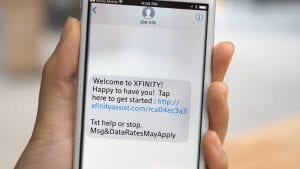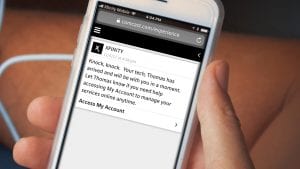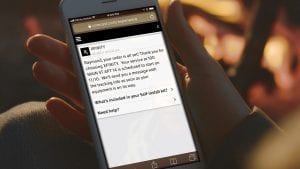What is the best way to solve a problem and make something easier to use? That’s the big question at Comcast, says Piers Lingle, the company’s senior vice president of customer experience.

Comcast uses technology to create solutions for their wide-ranging customer base, and they’re especially well-suited for those in Whatcom County. “These are very tech savvy customers,” says Lingle. “We don’t want them to have to call us if that is not their preferred way of communicating. We are consumers too and understand how many of us want to interact.”
Originally from Bellevue, Lingle is the former VP of product development, so he understands tech. His goal is to develop technology that empowers customers to get the most out of their services and overcome any challenges they may face. He says Comcast “is very much a technology company nowadays.”
Technology also helps them understand the needs of their customers and deliver products and services at the optimal moment. In short, Comcast is striving for an instant and seamless symbiosis of need and solution – and they’re well on their way to achieving it.
Comcast created an artificial intelligence (AI) based X1 voice remote, which is exactly what it sounds like: a voice activated television remote control. Of course the idea seems simple at the customer end, but on the tech side, the device is remarkably intelligent. It translates the customer’s spoken command into an intent. It’s asking “‘What do they mean by that?’” Lingle says, “And ‘What do they want?’ There’s over 20,000 ways to say, ‘I want to watch HBO,’ but they all boil down to the same intent.”

This piece of tech is extraordinary in this way. It focuses on intent, resulting in a better customer experience, something that has been years in the making.
But Comcast didn’t stop there. They kept digging into customer experience, looking to push to the next level, and discovered there are over 7,500 ways people ask to view their bill – all with the same intent. And, when looking at how customers work through a residential move, Comcast learned they want communication on the status of their services. A series of SMS texts or messages confirming dates and reminding customers of important upcoming events can alleviate stress.
For example, Lingle says they can send a text reminder pre-installer deployment, reminding a customer to unpack their TV so it’s ready for the technician. Small things like this make people feel taken care of. “We used our technology to understand, in this case, a move, and we mapped out the key moments of truth,” Lingle explains. This included confirmation of shut off and installation order, technician appointment reminders, and a reminder to ensure the TV was ready.
They call this truth-seeking communication process “RealTime Assist.” And they’ve mapped other journeys, too. What steps does a new customer take? What about a new business client – what are their needs? Comcast is working to answer these questions and more to better understand customers and improve their experience.

For those worried that this new level of communication might get annoying, Lingle says they’re careful with how much or how often they reach out. “Let’s not overload the customer,” he says. Instead, they’re thoughtful, seeking intuitive interactions. They’ve worked with nine million customers using this technology so far and, in each case, Lingle says they’re seeing improved satisfaction.
Then they noticed something else: When you send messages to customers, they often want to talk back. And when you remind them about an appointment, sometimes they need to reschedule.
Comcast rushed to meet that need with Xfinity Assistant, which doubled down on every advancement that preceded it. Customers could ask questions (in thousands of ways), schedule appointments, receive answers (intent discovery), and then respond back to those answers.
From the outset, Comcast wanted to create tech that responded to the unique needs of their customers. Lingle says they launched the Xfinity Assistant in November of 2017 and it’s now available in their “My Account” mobile app. The assistant can respond via SMS text, Facebook messenger and the Comcast website. It can also seamlessly hand off the customer to a live representative. For the tech savvy customer who wants help on their own terms, the assistant can also utilize asynchronous messaging so a customer can send a message to begin the chat, then go run an errand and resume the chat session later, when it’s more convenient.

“Comcast processes three billion events every single day,” Lingle says, with an “event” being one interaction, question or need met. That’s a lot of intent mapping. And Lingle is understandably proud of what they’ve accomplished.
Many of these interactions occurred in Washington State over the last year, a region that Lingle says is tech-savvy and open to interacting with Comcast via alternative channels. From January to November of 2018, 116,000 Washington customers interacted with the Xfinity Assistant, and started 642,000 conversations with RealTime Assist. Combined, Comcast helped 703,000 Washington customers better manage their service.
And they’re not done yet. “We want to get an answer to a customer before the customer knows they’ve got a question – that’s our ideal,” Lingle says. To get there, they intend to keep following this technology wherever their customers’ needs may lead.
Sponsored










































